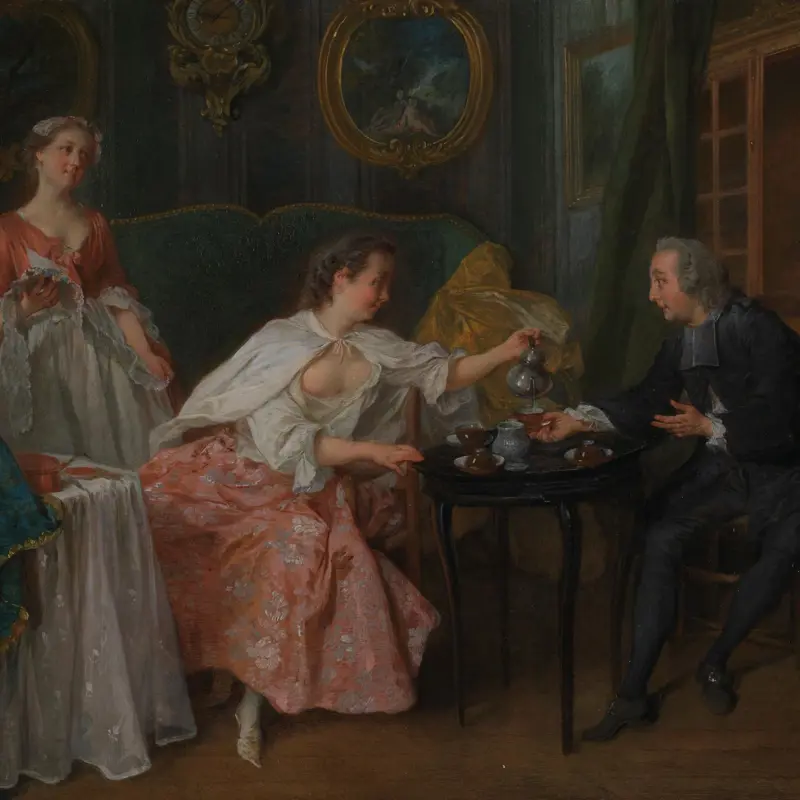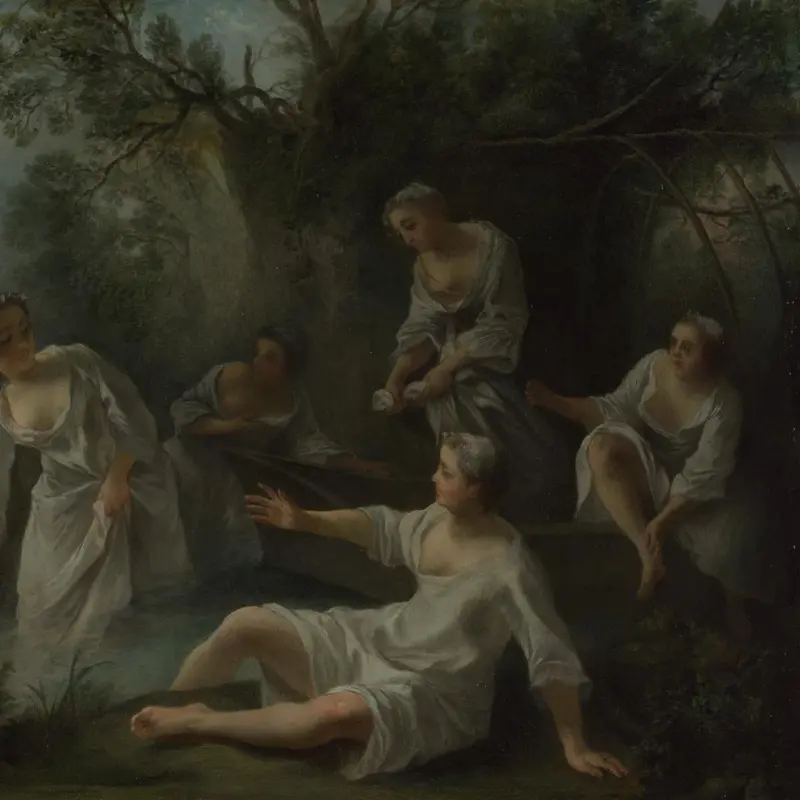Nicolas Lancret, 'The Four Times of Day: Evening', 1739-41
About the work
Overview
This is the final scene in Lancret’s series of paintings The Four Times of Day. By the silvery light of a spring or summer moon a group of women are bathing together in a woodland pond. One of the women standing in the pond is about to splash another who is lying on the ground, apparently testing the water with her foot. The other lady in the water covers her breast with her chemise and looks to her right as though she has heard a noise among the trees. One lady rubs her foot, apparently about to descend from the flat-bottomed boat, while another wrings out water from the hem of her shift.
Evening is in poor condition. Nicolas de Larmessin III’s print after the painting, presented to the Académie royale de peinture et de sculpture in 1741, suggests that it was once much more animated and finely detailed.
Key facts
Details
- Full title
- The Four Times of Day: Evening
- Artist
- Nicolas Lancret
- Artist dates
- 1690 - 1743
- Part of the series
- The Four Times of Day
- Date made
- 1739-41
- Medium and support
- oil on copper
- Dimensions
- 28.8 × 36.8 cm
- Acquisition credit
- Bequeathed by Sir Bernard Eckstein, 1948
- Inventory number
- NG5870
- Location
- Not on display
- Collection
- Main Collection
Provenance
Additional information
This painting is included in a list of works with incomplete provenance from 1933–1945; for more information see Whereabouts of paintings 1933–1945.
Text extracted from the ‘Provenance’ section of the catalogue entry in Humphrey Wine, ‘National Gallery Catalogues: The Eighteenth Century French Paintings’, London 2018; for further information, see the full catalogue entry.
Exhibition history
-
2011Paris: Life & LuxuryThe Getty Center Los Angeles26 April 2011 - 7 August 2011The Museum of Fine Arts (Houston)18 September 2011 - 10 December 2011
-
2021Hogarth and EuropeTate Britain1 November 2021 - 20 March 2022
Bibliography
-
1875E. Bocher, Les graveurs françaises du XVIIIe siècle, Paris 1875
-
1876E. Bocher, Les gravures françaises du XVIIIe siècle, Paris 1876
-
1924G. Wildenstein, Lancret, Paris 1924
-
1935A.C.R. Carter, 'Forthcoming Sales: Lancret at Last', The Burlington Magazine, LXVI/383, 1935, p. xiii
-
1955The National Gallery, The National Gallery: 1938-1954, London 1955
-
1957Martin Davies, National Gallery Catalogues: French School, 2nd edn (revised), London 1957
-
1991M.T. Holmes, 'Deux chefs-d'ouvre de Nicolas Lancret (1690-1743)', Revue du Louvre, XLI/1, 1991, pp. 40-2
-
1991M.T. Holmes, Nicolas Lancret, 1690-1743 (exh. cat. Frick Collection, 19 November 1991 - 12 January 1992; Kimbell Art Museum, 15 February - 12 April 1992), New York 1991
-
1993C. Korwin-Szymanowska, Nicolas Lancret's Four Times of Day: Tradition and Modernity, MA Thesis, Courtauld Institute of Art 1993
-
1995F. Gétreau, 'Les tableaux et les dessins français du XVIIIe siècle', Gazette des beaux-arts, CXXXVII, 1995, pp. 177-90
-
1997E. Langmuir, Allegory, London 1997
-
2001
C. Baker and T. Henry, The National Gallery: Complete Illustrated Catalogue, London 2001
-
2018Wine, Humphrey, National Gallery Catalogues: The Eighteenth Century French Paintings, London 2018
About this record
If you know more about this work or have spotted an error, please contact us. Please note that exhibition histories are listed from 2009 onwards. Bibliographies may not be complete; more comprehensive information is available in the National Gallery Library.
Images
About the series: The Four Times of Day

Overview
We do not know whether someone commissioned The Four Times of Day: Morning, Midday, Afternoon and Evening or whether Lancret produced them speculatively in the hope of making money from the engravings, since series of prints were popular with the public. Painting series of pictures was something of a speciality for Lancret – he had already produced The Four Seasons in about 1719, The Four Elements by August 1732, and The Four Ages of Man (also in the National Gallery’s collection) by July 1735. The Four Times of Day was complete by February 1741, when the engraver Nicolas de Larmessin III presented proofs of his engravings of them to the Académie Royale de Peinture et de Sculpture in Paris.
This series was painted on copper, which allowed for the fine and detailed brushwork we see here in the hands and faces of the principal figures, where Lancret made numerous small adjustments to produce particular expressions and gestures.









